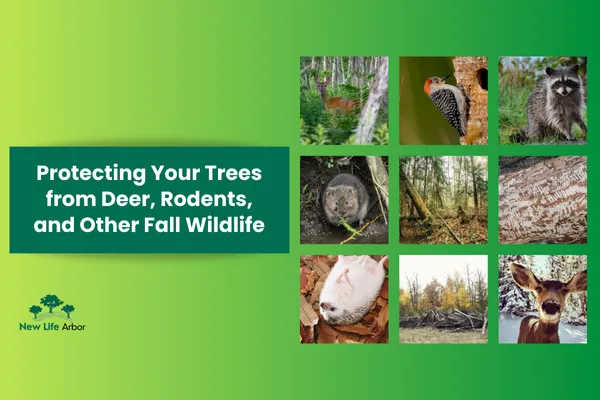
Protecting Your Trees from Deer, Rodents, and Other Fall Wildlife
As the leaves turn golden across Grand Rapids and the cool air settles in, your trees are entering their quiet season.
But fall is also when wildlife activity picks up—especially from animals that see your trees as a food source or scratching post.
From deer rubbing antlers on trunks to rodents gnawing at bark and roots, Michigan’s wildlife can quietly wreak havoc on your trees in October and beyond.
At New Life Arboricultural Services, we see the signs every fall—especially in neighborhoods near woods or water. So let’s dig into what to watch for, how to prevent damage, and how to keep your trees safe and strong through winter.

Deer Damage: More Than Just a Nuisance
Michigan’s white-tailed deer are most active in the fall, particularly October and November during rutting (mating) season. Bucks mark their territory by rubbing antlers against young tree trunks—peeling bark, breaking branches, and sometimes girdling the tree completely.
Signs of Deer Damage:
Bark stripped off 1–4 feet above the ground
Vertical scratches or gouges
Broken lower branches
Trees with split trunks or exposed cambium (the growth layer)
Why It’s a Problem:
That bark protects the tree’s lifeline. Once it’s damaged, the tree becomes vulnerable to disease, pests, and winter dieback. In worst cases, a girdled tree (where bark is removed all the way around) can’t transport nutrients and may not survive.

Rodents: The Hidden Chewers
Mice, voles, squirrels, and even rabbits all pose a threat to your trees—especially in fall when food becomes scarcer. They chew bark, strip roots, and burrow around the base of the trunk.
Rodent Damage Looks Like:
Gnawed bark near the ground or just under mulch
Tiny bite marks or “girdled rings” on saplings
Holes near the root zone or in mulch
Exposed roots or nests nearby
The Risk:
Rodent damage often goes unnoticed until spring when trees fail to leaf out properly or start dying back from the bottom up.

Bonus Menace: Beavers
(Yes, Really)
If you’re near a lake, river, or creek—especially in places like Spring Lake or Douglas—beaver activity is something to consider. They’ll take down small trees overnight and use them for dam building.
Clues Include:
Clean-cut tree stumps
Drag marks or worn paths to water
Missing saplings near water's edge

How to Protect Your Trees This Fall
Prevention is key when it comes to wildlife damage—especially because most of it happens when you’re not looking. Here are proven ways to protect your trees this October:
1. Install Tree Guards
Rigid plastic or wire mesh tree guards work wonders for keeping deer and rodents away from trunks.
Wrap them around the base of the tree (up to 5 feet high for deer)
Bury the bottom an inch or two to keep rodents from sneaking under
Use breathable material that doesn’t hold moisture against the bark
Tip: Don’t wrap too tightly. Your tree still needs airflow!
2. Try Deer Repellents
Scent-based sprays made from garlic, eggs, or hot pepper can deter deer from approaching. These should be reapplied every few weeks—or after heavy rain.
Best use: Early in the season before damage begins. Once a deer rubs a tree, it’s likely to return.
3. Reduce Attractants
Keep areas around your trees clean and less appealing to pests:
Don’t pile mulch too high—it provides hiding spots for rodents
Clean up fallen fruit or nuts that draw wildlife in
Remove brush or tall grass near tree bases
4. Protect Roots and Soil
For newly planted trees or shallow-rooted species, create a physical barrier using hardware cloth or fencing. This keeps animals from burrowing and helps retain moisture going into winter.
5. Monitor Your Trees Weekly
Fall can be deceptive—damage often happens quickly. Make it a habit to walk your yard and check for new marks, chew spots, or disturbed soil.

The Trees Most at Risk in West Michigan
If you live in Cascade, Ada, Rockford, or anywhere near wooded areas, wildlife damage is a higher risk. And certain tree types are deer favorites:
Red and Sugar Maples
Dogwoods
Fruit trees like apple, pear, and cherry
Young Oaks
Newly planted ornamentals
At New Life Arbor, we often recommend pairing tree selection with protection plans—especially if your property is in a known wildlife corridor.
What If There’s Already Damage?
Not all is lost. Some trees can recover from light deer rubs or rodent bites if caught early.
What we can do:
Assess structural damage
Apply tree wound dressing (when appropriate)
Recommend supports or pruning to encourage recovery
Remove severely compromised trees before winter hazards emerge
Don’t Wait for Snowfall to Notice the Damage
October is your window to act. Once the snow falls, it becomes much harder to spot early signs—and by spring, the damage could be irreversible.
By investing just a little time and effort now, you’re giving your trees the best chance to thrive in spring and beyond.
Want help evaluating your trees or installing protection before winter hits? Our certified arborists at New Life Arboricultural Services are here with expert care, Michigan kindness, and free estimates across Grand Rapids and West Michigan.
Visit https://newlifearbor.com/ to schedule your fall tree protection plan today.





